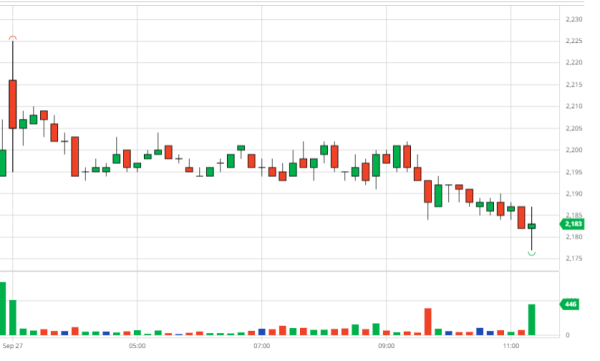The market trade voice requires Conab – Brazil to change the method of collecting and calculating crop data to get a more realistic figure…

Robusta chart London 11/2022 session on September 27, 2022
Ending the session, the price of Robusta coffee on ICE Europe – London dropped for the third consecutive session. The November spot term decreased by 24 USD, to 2,180 USD/ton and the delivery term in January 2023 decreased by 18 USD to 2,178 USD/ton, significant reductions. Trading volume maintained in maverage breast.
In contrast, the price of Arabica coffee on the ICE US floor – New York tends to be mixed. December spot futures added 0.55 cents to 224.35 cents/lb, while futures for delivery all fell. Specifically, the term for delivery in March 2023 decreased by 0.20 cents, to 216.30 cents/lb and the term for delivery in May 2023 decreased by 0.8 cents, to 211.50 cents/lb, gains/losses. significantly. Trading volume on average.
The price of green coffee beans in the Central Highlands provinces decreased by 300-400 dong, to range from 46,900 to 47,400 dong/kg.
Coffee prices continued to weaken after a series of central banks raised monetary interest rates right after the Fed – the US to help prevent the world economic recession and excessive inflation.
The stock market closed mixed as the rate hikes put a strain on most Wall Street investors. The slight upward correction in USDX continues to make it difficult for the values of emerging currencies and commodities in general to continue to weaken. The Reais exchange rate fell slightly by 0.03% to 1 USD = 5.3780 R$, which supported Brazilians to increase sales of agricultural products for export.
ICE’s Arabica inventories continued to decline to a 23-year low that kept the momentum going for New York’s spot goods as the price at the floor has now passed the gap compared to the wholesale price of the outside market. Especially after the Agricultural Products Forecasting and Supply Company (Conab) under the Brazilian Ministry of Agriculture reported the results of the third crop survey with a decrease in production, even though it is a seasonally high yield crop. “two years one” of coffee crops in Brazil, has contributed to global concerns of short-term supply shortages (!).
The market trade has complained about Conab’s data that is very unreasonable, causing difficulties for the market and reducing confidence in the supply and demand picture in Brazil, it is necessary to improve the methodology. calculate data to reflect reality more accurately. A statistic about the supply and demand of Reuters shows that within 5 years (from 2017 to 2021) Brazil has lost its balance (exports plus domestic consumption minus production) up to 32.19 million bags, where does it come from?
Take a look at some of the numbers on this year’s Brazilian crop circulating in the market. For example, Rabobank’s latest forecast is 63.2 million bags, compared to just 50.38 million bags in Conab’s revised forecast released on September 20. Consulting and analysis firm Safras & Mercados forecast 58 million bags, higher than Conab’s, while the US Department of Agriculture (USDA) estimated in June at 64.3 million bags.
English (giacaphe.com)
